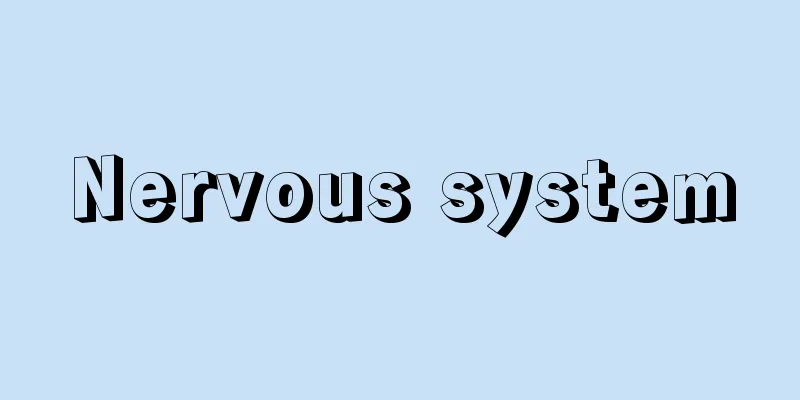Nervous system

|
The nervous system is one of the mechanisms responsible for transmitting information within the body, and its building block is the neuron (nerve cell). [The structure of the nervous system] Neurons receive signals from other neurons, and if the total amount of signals is large enough, they transmit the signals through synapses, which are the junctions between other neurons or effector organs such as muscles and glands. The complex chain of pathways formed by the connections between neurons is the nervous system, which plays a role in integrating each organ in the body and adapting the organism to its environment. Neurons are the building blocks of the nervous system, but they cannot function alone and require the presence of surrounding glial cells. Glial cells, which outnumber neurons by about 10 times, support neurons in their position, transfer glucose, an energy source, to neurons, and absorb waste and other unwanted substances. They also form myelin sheaths that surround axons, significantly accelerating the conduction velocity of action potentials. Blood vessels are spread throughout the brain, and blood supplies glucose, an energy source for neurons, and oxygen, which enables energy production. The endothelial cells of blood vessels prevent some substances in the blood from penetrating into the brain, allowing selective absorption. This is called the blood-brain barrier (BBB). The nervous system of invertebrates is not as concentrated as that of vertebrates, with nerve cells scattered throughout the body or ganglia consisting of groups of nerve cells. In vertebrates, there is a distinction between the central nervous system (CNS), which consists of the brain and spinal cord, and the peripheral nervous system, which connects the CNS to the periphery and internal organs of the body. The peripheral nervous system is further divided into the somatic nervous system and the autonomic nervous system. The somatic nervous system plays a role in transmitting sensory information and motor commands. In primates, it consists of 12 pairs of nerves (called cranial nerves) emerging from the brain, namely the olfactory nerve (I), optic nerve (II), oculomotor nerve (III), trochlear nerve (IV), trigeminal nerve (V), abducens nerve (VI), facial nerve (VII), vestibulocochlear nerve (VIII), glossopharyngeal nerve (IX), vagus nerve (X), accessory nerve (XI), and hypoglossal nerve (XII), and 31 pairs of nerves (called spinal nerves) emerging from the spinal cord, namely the cervical nerves (C1-C8), thoracic nerves (T1-T12), lumbar nerves (L1-L5), sacral nerves (S1-S5), and coccygeal nerve (Co) (however, the olfactory and optic nerves are central nerves, not peripheral nerves). The autonomic nervous system is divided into the sympathetic nervous system and the parasympathetic nervous system, and most internal organs are controlled by both the sympathetic and parasympathetic nervous systems in an antagonistic manner. The sympathetic nervous system, which increases heart rate and respiratory rate and inhibits digestive activity, is related to activities related to energy consumption, while the parasympathetic nervous system, which decreases heart rate and respiratory rate and increases digestive activity (such as saliva secretion and increased blood flow to the digestive organs), is related to activities that store energy in the body. The development of the brain and spinal cord begins with the appearance of the neural plate, a thickened part of the ectoderm, at 3 weeks of embryonic development. The outer parts of the neural plate rise on both sides and fuse together at the top to form the neural tube. Three brain regions, the forebrain, midbrain, and hindbrain, first appear at the anterior (rostral) side of the neural tube. Of these tissues, the forebrain eventually becomes the telencephalon and diencephalon, while the hindbrain becomes the hindbrain (cerebellum and pons) and myelencephalon (medulla oblongata). Neuroepithelial cells, which are the precursors of neurons and glial cells, make up the ventricular zone of the neural tube wall. Initially, cell division is symmetric, i.e., one precursor cell gives rise to two precursor cells, but then asymmetric division is observed, i.e., one precursor cell gives rise to one precursor cell and one other type of cell. At the beginning of asymmetric division, radial glia cells are born, and then neurons are born by asymmetric division. Neurons migrate toward the brain surface, and the cerebral cortex is formed from layer VI to shallower layers. The pattern in which neurons born later overtake neurons born earlier to form layers is called the inside-out pattern. When neurons migrate toward the brain surface, they generally travel through radial glia cells, but when radial glia cells differentiate into neurons, they may migrate as their own processes retract. Neurons that migrate to the correct location differentiate into various types of neurons and extend processes to make synaptic connections with appropriate targets. The structure at the tip of these processes is called the growth cone, and the growth cone recognizes chemical signals from the target and extends processes to the correct target by guidance or repulsion, forming synapses. After that, through the process of cell death called apoptosis and synaptic remodeling, the nervous system is remodeled into a more adaptive one, but this remodeling of the nervous system is not limited to the fetal period, but also occurs after birth and even in adults. Neuronal myelination also continues after birth, and in the case of human frontal association cortex neurons, myelination is completed about 20 years after birth. In the mature brain, neurogenesis occurs at least in the hippocampal dentate gyrus and olfactory bulb. The weight of the human brain is about 1400g for adult males and about 1300g for adult females. When looking at a cross section of the brain, it is divided into gray and white parts. The gray parts are called gray matter and the white parts are called white matter. Gray matter appears gray because it contains many neuronal cell bodies, and is therefore the area where neurotransmission between neurons takes place. White matter appears white because it contains many myelinated axons, and can be said to be the wiring that connects between parts of the brain. Of the gray matter of the cerebrum, the gray matter that is about 3 mm thick along the outer edge of the cerebrum is called the cerebral cortex. When neurons are stained, they have a structure of about six layers in every region, and from the brain surface they are called layer I, layer II, ..., layer VI. The cerebral cortex of primates has many sulci, and by hiding about two-thirds of the cerebral cortex within these sulci, the surface area of the cerebral cortex is significantly increased compared to other animal species, which is one of the reasons why it is believed that the cerebral cortex realizes the advanced mental functions unique to primates. In the brain, the gray matter in which the cell bodies of neurons are gathered together in a mass is called the nucleus. In the brain, there are spaces without brain tissue. These spaces, filled with cerebrospinal fluid (CSF), are called ventricles, and include the lateral ventricles (located on the left and right), the third ventricle, and the fourth ventricle, which communicate with each other through cerebrospinal fluid. The thin part connecting the third and fourth ventricles is called the cerebral aqueduct. The protective membranes surrounding the brain and spinal cord are called meninges, which consist of three layers: the dura mater, the arachnoid mater, and the pia mater. CSF also reaches the subarachnoid space between the arachnoid mater and the pia mater, so the brain is immersed in cerebrospinal fluid from both inside and outside. This reduces pressure on the base of the brain and also acts as a buffer to absorb external shocks. Cerebrospinal fluid is produced from blood in the choroid plexus located in the lateral ventricles, the third ventricle, and the fourth ventricle, and cerebrospinal fluid that flows out from the fourth ventricle passes through the subarachnoid space and is absorbed back into the bloodstream by the arachnoid granulations. There is no barrier between the ventricles and the brain, as there is between the blood vessels and the brain. Fibers that input to the central nervous system are called afferent fibers, and fibers that output from the central nervous system are called efferent fibers. Note that input to a certain brain region may be called afferent fibers, and output from there may be called efferent fibers. [Cerebrum] The cerebrum is divided into the left and right cerebral hemispheres, and its main components are the cerebral cortex, white matter (cerebral medulla), and basal ganglia (the term cerebrum is sometimes used synonymously with the telencephalon, or is sometimes used as a general term for the telencephalon and diencephalon, or as a general term for the telencephalon, diencephalon, and midbrain, but in this section it is used synonymously with the telencephalon). Numerous sulci can be seen on the surface of the cerebrum, and the parts that protrude between the sulci and are exposed on the surface are called gyrus. Based on the lateral sulcus, central sulcus, and parieto-occipital sulcus, the cerebral cortex is divided into four lobes: the frontal lobe, parietal lobe, temporal lobe, and occipital lobe. The fiber bundles connecting the cerebral cortex of both hemispheres are called commissural fibers, and include the corpus callosum and the anterior commissure. Although the cerebral hemispheres appear almost symmetrical, there are strict structural differences in the lateral sulcus and planum temporalis, and it is also known that functional lateralization of brain functions exists. Brodmann, K. (1909) noticed that the six-layer structure of the cerebral cortex differs depending on the location of the brain, and created a brain map by assigning a common number to areas with similar layer structures. Brodmann's brain map, consisting of areas 1 to 52 (with the exception of areas 48 to 51), is a cytoarchitectural classification, but it also corresponds well to functions, and this brain map is often used in psychology. For example, the primary visual cortex corresponds to area 17, the primary auditory cortex to areas 41 to 42, the primary motor cortex to area 4, and the primary somatosensory cortex to areas 1 to 3. The parts of the cerebral cortex other than the motor cortex and the sensory cortex are called the association cortex. Figure 1 shows the correspondence between the main cortical areas and Brodmann's brain map. The hippocampus is located deep on the medial surface of both the left and right temporal lobes, and is a developmentally ancient cortical region. Although it is sometimes used synonymously with the hippocampal formation, the hippocampus actually refers to the cornu ammonis, and the entire area including the cornu ammonis, the dentate gyrus, and the subiculum is called the hippocampal formation. The hippocampal formation receives input from the entorhinal cortex, and after unidirectional signal transmission via the dentate gyrus and the cornu ammonis, there are projections from the cornu ammonis and the subiculum to the septum via the fimbria and to the mammillary body via the fornix, and there are also fibers returning from the subiculum to the entorhinal cortex. The hippocampus is considered one of the loci of memory, and research into synaptic plasticity is progressing. The amygdala is a nuclear complex located in the anterior medial aspect of the left and right temporal lobes, and is composed of the basolateral nuclei (basal ganglia and lateral nuclei) and the cortical medial nuclei (cortical nuclei and central nuclei). Olfactory input terminates in the basolateral nuclei, which are interconnected with various cortical regions. The main output pathways are the stria terminalis and the ventral amygdala output pathway. Electrical stimulation of the amygdala elicits a variety of autonomic and emotional responses. The basal ganglia are a group of nerve nuclei located deep in the white matter. They generally refer to the striatum (i.e. the caudate nucleus and putamen), globus pallidus, subthalamic nucleus, and substantia nigra, but the definition is vague, as the term may refer only to the striatum and globus pallidus, with the subthalamic nucleus considered to be a diencephalic nucleus and the substantia nigra considered to be a midbrain nucleus, or may include other nerve nuclei. The basal ganglia play an important role in controlling movement, and basal ganglia diseases include Parkinson's disease (stiffness of the limbs and difficulty in initiating movements, caused by loss of dopaminergic neurons in the substantia nigra compacta) and Huntington's disease (impulsive involuntary movements of the limbs, caused by loss of striatal neurons projecting to the external segment of the globus pallidus). The term "limbic system" refers to the phylogenetically ancient limbic parts of the cerebral hemispheres and the parts that surround the brain stem and communicate with each other, and is a functional unit closely related to motivation and emotion. The cortical regions included in the limbic system are the cingulate gyrus, parahippocampal gyrus, parolfactory area, hippocampal formation, fornix, septum pellucidum, diagonal band of Broca, paraterminal gyrus, and amygdala. The subcortical tissues that are closely connected to these with fibers (mammillary bodies, anterior thalamic nuclei, habenular nuclei, and dorsal tegmental nucleus of the midbrain) may also be included in the limbic system. [Diencephalon] The diencephalon is located around the third ventricle and between the cerebrum and the midbrain. The cerebrum and diencephalon together are called the forebrain. The diencephalon consists of four layers: the epithalamus, the dorsal thalamus, the ventral thalamus, and the hypothalamus. In a broad sense, the thalamus refers to the epithalamus, dorsal thalamus, and ventral thalamus, while in a narrow sense, the thalamus corresponds to the dorsal thalamus. The left and right thalamus are connected by commissural fibers called the interthalamic adhesion. The epithalamus consists of the pineal body, which produces and secretes melatonin, and the habenula, which relays the connection between the olfactory center and the brainstem. The dorsal thalamus includes specific thalamic nuclei (i.e., anterior nuclei, medial nuclei, paralateral nuclei, lateral geniculate nucleus, medial geniculate nucleus, pulvinar, and reticular thalamic nucleus) that receive sensory input and relay it to the cerebral cortex, and unspecific thalamic nuclei (i.e., midline thalamic nucleus and intralaminar thalamic nucleus) that are not connected to the cerebral cortex but are connected to the brainstem. Of these, the lateral geniculate nucleus contains neurons that receive input from the retina and send fibers to the primary visual cortex, and the medial geniculate nucleus contains neurons that receive input from the auditory system and send fibers to the primary auditory cortex. The ventral thalamus is a continuation of the midbrain tegmentum and includes the zona incerta and the subthalamic nucleus (the subthalamic nucleus is sometimes included in the basal ganglia). The main structures of the hypothalamus include the preoptic area, supraoptic nucleus, paraventricular nucleus, ventromedial nucleus, dorsomedial nucleus, infundibular nucleus, mammillary bodies, and suprachiasmatic nucleus. The hypothalamus is the control center of the autonomic nervous system, and also influences the endocrine system, as the neuroendocrine cells of the hypothalamus release hormones to control hormone secretion from the anterior pituitary gland, and the axon terminals of neurons with cell bodies in the hypothalamus extend to the posterior pituitary gland and secrete hormones from there. [Cerebellum] The cerebellum is located on the dorsal side of the medulla oblongata and consists of the central vermis and the cerebellar hemispheres on either side. At the outer edge of the cerebellum is the cerebellar cortex, which consists of three layers from the surface to the depth: the molecular layer, the Purkinje cell layer, and the granular layer. Below the cerebellar cortex is white matter, and even deeper are the deep cerebellar nuclei, namely the medial, intermediate, and lateral nuclei. The cerebellar peduncle is connected to the brainstem by the cerebellar peduncle (superior cerebellar peduncle, middle cerebellar peduncle, and inferior cerebellar peduncle). The superior cerebellar peduncle mainly consists of efferent fibers from the cerebellum to the thalamus and brainstem, while the middle cerebellar peduncle and inferior cerebellar peduncle mainly consist of afferent fibers to the cerebellum. The cerebellum is important for motor control and motor learning. [Brain stem] The midbrain, pons, and medulla oblongata are collectively called the brain stem. The midbrain is divided into the mesencephalic tectum (which is located dorsally) and the cerebral peduncle (which is located ventrally) by the aqueduct that runs from the ventricles. The mesencephalic tectum is made up of the superior colliculus (superior colliculus) and the inferior colliculus (inferior colliculus). The superior colliculus receives information from the retina, and the inferior colliculus relays auditory information. The dorsal part of the cerebral peduncle is called the mesencephalic tegmentum, which includes the reticular formation, the substantia nigra (as mentioned above, the substantia nigra is sometimes included in the basal ganglia), the red nucleus, the oculomotor nucleus, the Edinger-Westphal nucleus, the trochlear nucleus, and the mesencephalic trigeminal nucleus. The area extending downward from the midbrain is called the pons, and the ventral part, separated by the medial leminiscus, is called the base of the pons, and the dorsal part is called the pontine tegmentum. The base of the pons is dotted with pontine nuclei, and the pontine tegmentum contains the locus ceruleus, a collection of noradrenergic neurons, as well as several motor and sensory cranial nerve nuclei. The pons is involved in wakefulness and sleep, especially REM sleep. The medulla oblongata is the transitional area between the brain and the spinal cord, with a protuberance called the olive and pyramidal tracts in the ventral part, and multiple cranial nerve nuclei in the dorsal part, or tegmentum. It has vital functions such as breathing, the cardiovascular system, and digestion. Neurons in the inferior olivary nucleus in the olive send fibers to the cerebellum, which become climbing fibers and form synapses on the dendrites of Purkinje cells. The relative positions of the main brain parts from the cerebrum to the medulla oblongata are shown in Figures 2 and 3 on pages 373 and 374. [Spinal cord] The spinal cord is a long cylindrical tissue that is immersed in cerebrospinal fluid and is contained within the vertebral column. From the side closest to the brain, it is called the cervical cord, the thoracic cord, the lumbar cord, and the sacral cord. However, the spinal cord itself does not have a clear segmental structure, and the distinction is based on the 31 pairs of spinal nerves. The spinal cord root that extends downward from the end of the spinal cord is called the cauda equina. When looking at the cross section of the spinal cord, the positional relationship between the gray matter and the white matter is different from that of the brain, with the gray matter inside forming an H-shape like a butterfly, surrounded by the white matter. The ventral part of the gray matter is called the anterior horn, and the dorsal part is called the dorsal horn. The anterior horn is the part that mainly contains motor neurons, and the posterior horn is the part that contains ascending neurons that receive sensory input and send axons to the brain. The gray matter also contains many interneurons that project into the spinal cord. White matter is divided into three parts: the ventral funiculus, the lateral funiculus, and the dorsal funiculus. White matter contains ascending pathways (sensory pathways) that run toward the brain and descending pathways (motor pathways) that run downward (caudal) of the spinal cord. The input/output sites between the periphery and the spinal cord are the dorsal root and the ventral root, with sensory input from the periphery coming from the dorsal root and motor output to the periphery coming from the ventral root (Bell-Magendie law). Sensory input can reach the brain via the ascending pathway of the spinal cord, or the spinal cord can receive sensory input and directly emit a motor output at the spinal cord level. The latter is called the spinal reflex. →Visual area →Neurotransmission →Somatosensory area →Basal ganglia →Cerebral hemisphere dominance →Limbic system →Auditory area [Okada Takashi] "> Figure 3 Frontal section of the brain "> Figure 2-C Underside of the brain "> Figure 2-B: Midline section of the brain "> Figure 2-A: Main parts of the brain (lateral surface) The top is a lateral view, the bottom is a median view. The numbers represent Broadmann's brain map . Figure 1. Cortical areas of the cerebral hemispheres Latest Sources Psychology Encyclopedia Latest Psychology Encyclopedia About Information |
|
神経系は生体内における情報伝達をつかさどる機構の一つであり,構成単位となる細胞はニューロンneuron(神経細胞)である。 【神経系の成り立ち】 ニューロンは,ほかのニューロンから信号を受け取り,その信号の総体が十分に大きい場合,別のニューロンや筋肉・腺などの効果器との接合部位であるシナプスsynapseを介して信号を伝達する機能をもつ。ニューロン同士の結合により形成された複雑な連鎖路がすなわち神経系であって,身体内の各器官を統合しその生体を環境に適応させる役割を果たす。 神経系の構成単位はニューロンであるが,それ単独で機能できるわけではなく,周囲のグリア細胞glial cellの存在が必要である。数のうえではニューロンの約10倍と圧倒的に多いグリア細胞は,ニューロンをその位置に支持するとともに,エネルギー源であるグルコースglucoseのニューロンへの受け渡しや不要物・老廃物の取り込みを行ない,さらに軸索の周囲を取り巻く髄鞘を形成して活動電位の伝導速度を著しく速める役割も果たす。また,脳には至る所に血管が張りめぐらされ,ニューロンのエネルギー源となるグルコースや,エネルギー産生を可能にする酸素が血液によって供給される。血管の内皮細胞の働きにより血中の物質の一部は脳内への透過が阻害され,選択的な取り込みがなされる。このことを血液-脳関門blood-brain barrier(BBB)という。 無脊椎動物の神経系は,神経細胞が体中に散在するだけのものや神経細胞集団からなる神経節が並んだものであって,脊椎動物の神経系ほど集約的ではない。脊椎動物においては,脳brainと脊髄spinal cordからなる中枢神経系central nervous system(CNS)と,中枢神経系と身体の末梢部や内臓とを結ぶ末梢神経系peripheral nervous systemとが区別される。末梢神経系はさらに体性神経系somatic nervous systemと自律神経系autonomic nervous systemに分けられる。体性神経系は感覚情報や運動命令を伝える役割を果たし,霊長類の場合,脳から出ている12対の神経(脳神経cranial nerveという),つまり嗅神経(Ⅰ),視神経(Ⅱ),動眼神経(Ⅲ),滑車神経(Ⅳ),三叉神経(Ⅴ),外転神経(Ⅵ),顔面神経(Ⅶ),内耳神経(Ⅷ),舌咽神経(Ⅸ),迷走神経(Ⅹ),副神経(Ⅺ),舌下神経(Ⅻ)と,脊髄から出ている31対の神経(脊髄神経spinal nerveという),つまり頸神経(C1~C8),胸神経(T1~T12),腰神経(L1~L5),仙骨神経(S1~S5),尾骨神経(Co)から成る(ただし,嗅神経と視神経は末梢神経ではなく中枢神経である)。自律神経系は交感神経系sympathetic nervous systemと副交感神経系parasympathetic nervous systemに分類され,大多数の内臓がこの交感・副交感両方の神経系による拮抗的支配を受けている。心拍数や呼吸数の上昇と消化活動の抑制を生じさせる交感神経系はエネルギー消費にかかわる活動に関連し,逆に心拍数や呼吸数の減少と消化活動の増加(唾液の分泌や消化器への血流増加など)を生じさせる副交感神経系はエネルギーを身体に蓄える活動に関連する。 脳と脊髄の発生は,外胚葉の肥厚した部分である神経板neural plateが胎生3週で出現することに始まる。神経板の外側部分が両側で隆起し,上部で互いに融合して神経管neural tubeが形成される。神経管の前方(吻側)に三つの脳領域すなわち前脳forebrain,中脳midbrain,菱脳hindbrainがまず現われる。これらの組織のうち,前脳は最終的に終脳telencephalonと間脳diencephalonになり,菱脳は後脳metencephalon(小脳cerebellumと橋pons)と髄脳myelencephalon(延髄medulla oblongata)になる。ニューロンとグリア細胞の前駆細胞となる神経上皮細胞neuroepithelial cellが,神経管壁の脳室帯ventricular zoneを構成しており,当初見られる細胞分裂は対称分裂,すなわち一つの前駆細胞から二つの前駆細胞が生じる分裂であるが,やがて非対称分裂,すなわち一つの前駆細胞から一つの前駆細胞と一つの別のタイプの細胞が生じる分裂が見られる。非対称分裂の初期には放射状グリア細胞radial gliaが生まれ,その後にニューロンが非対称分裂によって生まれるようになる。ニューロンは脳表の方向へと移動し,大脳皮質が第Ⅵ層から順に浅い層へと形成されていく。この後に生まれたニューロンが,先に生まれたニューロンを追い越すように移動して層を形成していく様式を,インサイドアウトinside-outパターンという。ニューロンが脳表面方向に移動する際,放射状グリア細胞を伝わっていくことが一般的だが,放射状グリア細胞が分化してニューロンになった場合は,そのニューロン自身の突起の退縮に伴って移動することもある。あるべき位置に移動したニューロンはさまざまな種類のニューロンに分化し,適切な標的とシナプス結合するために突起を伸張させる。この突起の先端部の構造を成長円錐growth coneといい,標的からの化学信号を成長円錐が認識し誘導もしくは反発により正しい標的へと突起を伸ばし,シナプス形成をする。その後,アポトーシスapoptosisとよばれる細胞死やシナプス再構築の過程を経て,より適応的な神経系へと作り替えられるが,神経系の再構築は胎生期に限られるものではなく出生後も生じ,さらに成体においても見られる。ニューロンの髄鞘形成についても出生後さらに続き,人間の前頭連合野ニューロンの場合,生後約20年かけて髄鞘化を完成させる。成熟した脳でのニューロン新生neurogenesisが,少なくとも海馬歯状回と嗅球で生じている。 人間の脳の重さは成人男性で約1400g,成人女性で約1300gである。脳の断面を見ると灰色の部分と白色の部分とに区別される。この灰色の部分を灰白質gray matter,白色の部分を白質white matterという。灰白質にはニューロンの細胞体が多く含まれているため灰色に見えており,したがって灰白質はニューロン間の神経伝達が行なわれている部位である。白質は髄鞘化された軸索が多く含まれることから白色に見えており,脳部位間の連絡をする配線部であるといえる。大脳の灰白質のうち,大脳の外縁に沿った厚さ約3mmの灰白質をとくに大脳皮質cerebral cortexとよぶ。ニューロンを染色するとどの領域においてもほぼ6層構造となっており,脳表から順に第Ⅰ層,第Ⅱ層,……,第Ⅵ層と称する。霊長類の大脳には多数の脳溝が存在し,大脳皮質の約3分の2を脳溝の中に隠すことによって大脳の表面積を他の動物種に比べ著しく増大させており,大脳皮質が霊長類特有の高度な精神機能を実現していると考える一つの根拠となっている。なお,脳においてニューロンの細胞体が塊状をなして集合した灰白質のことを核nucleusもしくは神経核という。 脳には,脳組織のない空間部分が見いだされる。脳脊髄液cerebrospinal fluid(CSF)に満たされたこの部分を脳室ventricleといい,側脳室lateral ventricle(左右にある),第3脳室third ventricle,第4脳室fourth ventricleがあって,互いに脳脊髄液が交通している。第3脳室と第4脳室を結んでいる細い部分を中脳水道cerebral aqueductという。また,脳や脊髄の周囲にある保護膜を髄膜meningesといい,硬膜・クモ膜・軟膜の3層から成るが,クモ膜と軟膜の間のクモ膜下腔にも脳脊髄液が達しており,脳は内外の脳脊髄液に浸されて存在していることになる。このため脳底面にかかる圧力は軽減され,また外部からの衝撃を和らげる緩衝作用がある。脳脊髄液は,側脳室・第3脳室・第4脳室に存在する脈絡叢choroid plexusで血液から作られており,第4脳室から流れ出た脳脊髄液はクモ膜下腔を経てクモ膜顆粒から血流へと再び吸収される。脳室と脳との間には,血管と脳との間にあるような関門は存在しない。 中枢神経系への入力線維のことを求心性線維afferent fiber,中枢神経系からの出力線維のことを遠心性線維efferent fiberとよぶ。なお,ある脳部位への入力を求心性線維,そこからの出力を遠心性線維とよぶ場合もある。 【大脳cerebrum】 大脳は左右の大脳半球cerebral hemisphereに分かれており,その主な構成要素は大脳皮質,白質(大脳髄質),大脳基底核である(大脳という用語は,終脳と同義に用いられる場合もあるし,終脳と間脳の総称,あるいは終脳・間脳・中脳の総称として用いられることもあるが,本項では終脳と同義に用いている)。大脳の表面には多数の脳溝sulcusが見られ,脳溝と脳溝の間で隆起して表面に露出している部分を脳回gyrusという。外側溝lateral sulcus,中心溝central sulcus,頭頂後頭溝parieto-occipital sulcusを基準にして,大脳皮質を四つの葉,すなわち前頭葉frontal lobe,頭頂葉parietal lobe,側頭葉temporal lobe,後頭葉occipital lobeに区分する。両半球の大脳皮質を結ぶ線維束を交連線維commissural fiberといい,脳梁corpus callosumおよび前交連anterior commissureがある。大脳半球はほぼ左右対称に見えるが,厳密には外側溝や側頭平面における構造上の差異が見られ,また機能的にも脳機能の側性化のあることが知られている。 ブロードマンBrodmann,K.(1909)は,大脳皮質の6層構造の様相が脳の場所によって異なることに着目し,類似の層構造を有する領域に共通の番号を付すことにより脳地図を作成した。第1野から第52野(ただし第48~51野は欠番)からなるブロードマンの脳地図Brodmann's brain mapは,細胞構築学的な分類であるが機能ともよく対応しており,心理学においてもこの脳地図がよく用いられる。たとえば,一次視覚皮質は第17野,一次聴覚皮質は第41~42野,一次運動皮質は第4野,一次体性感覚皮質は第1~3野といった対応がある。なお,大脳皮質のうち,運動皮質motor cortexと感覚皮質sensory cortex以外の部分を連合皮質association cortexという。主な皮質領域とブロードマンの脳地図との対応を図1に示す。 海馬hippocampusは左右の側頭葉の内側面深部にあり,発生的に古い皮質領域である。海馬体と同義に用いられることもあるが,海馬とはアンモン角cornu ammonisのことであり,それと歯状回dentate gyrusおよび海馬台subicullumを含めた全体を海馬体hippocampal formationという。海馬体は嗅内皮質entorhinal cortexからの入力を受け,歯状回やアンモン角を介した一方向性の信号伝達の後,アンモン角や海馬台から海馬采を介して中隔に,脳弓を介して乳頭体に投射があり,また海馬台から嗅内皮質へ戻る線維がある。海馬は記憶の座の一つとみなされており,シナプス可塑性の研究が進んでいる。 扁桃体amygdalaは左右の側頭葉内側面前方にある核複合であって,基底外側核群(基底核と外側核)と皮質内側核群(皮質核と中心核)から成る。基底外側核群に嗅覚入力が終わっており,基底外側核群はさまざまな皮質領域と相互結合している。主要な出力路は分界条と扁桃体腹側出力路である。扁桃体の電気刺激によってさまざまな自律反応や情動反応が惹起される。 大脳基底核basal gangliaは白質の深部に位置している神経核群である。線条体striatum(すなわち尾状核caudate nucleusと被殻putamen),淡蒼球globus pallidus,視床下核,黒質substantia nigraのことを一般に指すが,視床下核を間脳の核,黒質を中脳の核と考えて線条体と淡蒼球だけを指して大脳基底核という場合や,別の神経核を含む場合もあり,定義は曖昧である。大脳基底核は運動の制御において重要な役割を果たしており,大脳基底核疾患としてパーキンソン病Parkinson's disease(手足の硬直や動作開始困難が生じ,黒質緻密部のドーパミン作動性ニューロンの脱落による)やハンチントン病Huntington's disease(四肢の衝動性不随意運動が生じ,淡蒼球外節に投射している線条体ニューロンの脱落による)などがある。 大脳辺縁系limbic systemという名称は,系統発生学的に古い大脳半球辺縁部,および脳幹を取り囲むように位置し相互に連絡する部位の総称であり,動機づけや情動との関係が深い機能単位である。大脳辺縁系に含まれる皮質領域は,帯状回cingulate gyrus,海馬傍回parahippocampal gyrus,嗅傍野parolfactory area,海馬体,脳弓fornix,透明中隔septum pellucidum,ブローカの対角帯diagonal band of Broca,終板傍回paraterminal gyrus,扁桃体である。これらと密接に線維結合している皮質下の組織(乳頭体,視床前核,手綱核,中脳の背側被蓋核)も大脳辺縁系に含める場合がある。 【間脳diencephalon】 間脳は第3脳室の周囲にあって大脳と中脳の間にある。大脳と間脳を合わせて前脳という。間脳は,視床上部epithalamus,背側視床dorsal thalamus,腹側視床ventral thalamus,視床下部hypothalamusの四つの層からなる。広義の視床thalamusは視床上部・背側視床・腹側視床を指し,また狭義の視床は背側視床に相当する。左右の視床は視床間橋interthalamic adhesionという交連線維でつながっている。視床上部は,メラトニンの産生と分泌を行なう松果体pineal bodyと,嗅覚中枢と脳幹との結合路を中継する手綱核からなる。背側視床には,感覚系の入力を受けて大脳皮質に中継する視床特殊核specific thalamic nuclei(すなわち前核群,内側核群,副外側核群,外側膝状体核,内側膝状体核,視床枕,視床網様核)と,大脳皮質とは結合をもたずに脳幹と結合する視床非特殊核unspecific thalamic nuclei(すなわち視床正中線核と視床髄板内核)が含まれる。このうち,外側膝状体核lateral geniculate nucleusには網膜からの入力を受け一次視覚野に線維を送るニューロンがあり,内側膝状体核medial geniculate nucleusには聴覚系からの入力を受け一次聴覚野に線維を送るニューロンがある。腹側視床は中脳被蓋の続きであって不確帯zona incertaと視床下核subthalamic nucleusが含まれる(視床下核を大脳基底核に含めることもある)。視床下部の主な構造として,視索前野,視索上核,室傍核,腹内側核,背内側核,漏斗核,乳頭体,視交叉上核が挙げられる。視床下部は自律神経系の制御中枢であり,また視床下部の神経内分泌細胞neurosecretory cellがホルモンを放出し脳下垂体前葉anterior pituitary glandのホルモン分泌を制御したり,視床下部に細胞体のあるニューロンの軸索終末部が脳下垂体後葉posterior pituitary glandに伸びそこからホルモンを分泌したりするように,視床下部は内分泌系にも影響を及ぼしている。 【小脳cerebellum】 小脳は延髄の背側にあって,中央部分の虫部と,その両側の小脳半球とから成る。小脳の外縁部には小脳皮質cerebellar cortexがあり,表面から深部方向に分子層,プルキンエ細胞層(プルキニエ細胞層),顆粒層の3層から成っている。小脳皮質の下には白質があり,さらにその深部には小脳深部核deep cerebellar nucleusすなわち内側核,中位核,外側核がある。小脳脚cerebellar peduncle(上小脳脚,中小脳脚,下小脳脚)によって脳幹と結合しており,上小脳脚は主に小脳から視床・脳幹に向かう遠心性線維,中小脳脚と下小脳脚は主に小脳への求心性線維からなる。小脳は運動の制御や運動学習に重要である。 【脳幹brain stem】 中脳,橋,延髄を総称して脳幹という。中脳は,脳室から続く中脳水道を境にして,それよりも背側の中脳蓋mesencephalic tectumと腹側の大脳脚crus cerebriとから成る。中脳蓋は四丘体すなわち上丘superior colliculusと下丘inferior colliculusから成っており,上丘は網膜からの情報を受け取り,下丘は聴覚情報を中継する。大脳脚のうち背側部分を中脳被蓋mesencephalic tegmentumとよび,ここには網様体reticular formation,黒質(前述のように黒質を大脳基底核に含めることもある),赤核red nucleus,動眼神経核,エディンガー・ウェストファル核,滑車神経核,三叉神経中脳核が含まれる。 中脳から下方に続く部位を橋ponsといい,内側毛帯medial leminiscusを境にして腹側部を橋底部,背側部を橋被蓋とよぶ。橋底部には橋核が散在しており,橋被蓋にはノルアドレナリン作動性ニューロンの集合である青斑核locus ceruleusや,複数の運動性脳神経核・感覚性脳神経核がある。橋は覚醒と睡眠,とくにレム睡眠に関与する。 延髄は脳と脊髄の移行部であり,腹側部にはオリーブとよばれる隆起と錐体路が,背側部つまり被蓋には複数の脳神経核がある。呼吸・心臓血管系・消化などの生命維持機能を有する。オリーブの部分にある下オリーブ核のニューロンは,小脳に線維を送り登上線維となってプルキンエ細胞の樹状突起上にシナプス形成をしている。大脳から延髄までの,主な脳部位の位置関係を373・374ページ図2と図3に示す。 【脊髄spinal cord】 脊髄は脳脊髄液に浸されて脊柱vertebral columnの中に納まっている長い円柱状の組織である。脳に近い側から順に,頸髄cervical cord,胸髄thoracic cord,腰髄lumbar cord,仙髄sacral cordとよばれるが,脊髄そのものに明確な分節構造が見られるわけではなく,31対の脊髄神経に基づく区別である。また,脊髄の終端から下方に伸びる脊髄根のことを馬尾cauda equinaという。脊髄の横断面を見ると灰白質と白質の位置関係が脳とは異なっていて,灰白質は蝶の形のようなH型を示して内部にあり,その周囲を白質が囲むという構造である。灰白質の腹側部分を前角ventral horn,背側部分を後角dorsal hornといい,前角は主に運動ニューロンを含む部分,後角は感覚入力を受け脳に軸索を送る上行路ニューロンを含む部分であり,また灰白質には投射先が脊髄内である介在ニューロンが多数含まれる。白質は前索ventral funiculus,側索lateral funiculus,後索dorsal funiculusという三つの部位に分けられる。白質には脳の方向へ進む上行路(知覚路)と脊髄の下方(尾方)へ進む下行路(運動路)が含まれる。末梢と脊髄との入出力部位は後根dorsal rootと前根ventral rootであり,末梢からの感覚性入力は後根から,末梢への運動性出力は前根からなされる(ベル-マジャンディーの法則Bell-Magendie law)。感覚性入力は脊髄の上行路を介して脳に到達する場合と,脊髄が感覚性入力を受けてそのまま脊髄レベルで運動性出力を発する場合とがあり,後者は脊髄反射spinal reflexといわれる。 →視覚領野 →神経伝達 →体性感覚領野 →大脳基底核 →大脳半球優位性 →大脳辺縁系 →聴覚領野 〔岡田 隆〕 "> 図3 脳の前額断面 "> 図2-C 脳の下面 "> 図2-B 脳の正中断面 "> 図2-A 脳の主要な部位(外側面) 上は側面図,下は正中面図。数字はブロー ドマンの脳地図を表わす"> 図1 大脳半球の皮質野 出典 最新 心理学事典最新 心理学事典について 情報 |
<<: Neuroglia - Shinkeikou (English spelling)
Recommend
Shizunai [town] - Shizunai
A former town in Shizunai County in south-central ...
Departure meal - Idetachi no Zen
…After the monks' ceremony, the coffin is tak...
bustān (English spelling) bustan
At the same time, it should be noted that the ind...
Electric discharge machining (English spelling)
When a voltage is applied between metal electrode...
Projectile motion
The motion of an object thrown into space with un...
Emperor Wen
The fifth emperor of the Western Han dynasty of C...
Thíra (English spelling)
…A volcanic island in the Cyclades in the Aegean ...
Thurnwald - Richard Thurnwald
German ethnologist and social anthropologist. Bor...
Air mass - Kidan
A mass of air that has roughly the same horizonta...
Citizens - kokumin
A person who constitutes a nation and has the nati...
Low calorie foods - low calorie diet
Foods that have reduced calorie sources such as su...
Bokassa, JB (English spelling) BokassaJB
...David Dacko, who became the first president, o...
Tokelau [Islands] - Tokelau
An archipelago consisting of three atolls in the s...
Curry, JS (English spelling) CurryJS
...After that, a generation that had assimilated ...
Residents' movement - Juminundou
It refers to a movement based on horizontal solid...









